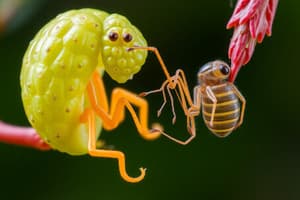Podcast
Questions and Answers
What is the defining characteristic of sexual reproduction?
What is the defining characteristic of sexual reproduction?
- Fusion of two diploid gametes
- Involves the fusion of two haploid gametes (correct)
- Results in no genetic variation
- Occurs only in plants
Which process refers to the fusion of two gametes to form a diploid zygote?
Which process refers to the fusion of two gametes to form a diploid zygote?
- Germination
- Embryonic development
- Asexual reproduction
- Fertilization (correct)
In sexual reproduction, what contributes to genetic variation in offspring?
In sexual reproduction, what contributes to genetic variation in offspring?
- Formation of identical offspring
- Recombination of genetic material from both parents (correct)
- The fusion of gametes producing the same genetic material
- Gametes with no genetic information
Which type of reproduction is characterized by the absence of gamete fusion?
Which type of reproduction is characterized by the absence of gamete fusion?
What is a common feature of asexual reproduction?
What is a common feature of asexual reproduction?
What is the main difference between fertilization in specialized structures and fertilization in general?
What is the main difference between fertilization in specialized structures and fertilization in general?
How does germination contribute to sexual reproduction?
How does germination contribute to sexual reproduction?
What is a key characteristic of embryonic development in multicellular organisms?
What is a key characteristic of embryonic development in multicellular organisms?
Which statement accurately distinguishes asexual reproduction from sexual reproduction?
Which statement accurately distinguishes asexual reproduction from sexual reproduction?
Which method of asexual reproduction involves the parent breaking into smaller pieces that develop into separate individuals?
Which method of asexual reproduction involves the parent breaking into smaller pieces that develop into separate individuals?
Flashcards are hidden until you start studying
Study Notes
Organism Reproduction: A Diversified Approach to Continuity
Organisms thrive due to their ability to reproduce, passing on their genetic material to offspring that are uniquely suited to their environments. Two primary methods for reproduction exist: sexual and asexual. Each method has its distinct characteristics that we'll explore, alongside the processes of fertilization, germination, and embryonic development.
Sexual Reproduction
This form of reproduction involves the fusion of two haploid gametes (sperm and egg) to form a diploid zygote. The gametes contain half the genetic information of the parent organism, and after fertilization, the zygote acquires a complete set of genetic instructions. Sexual reproduction results in genetic variation due to the recombination of genetic material from both parents, enhancing their offspring's ability to adapt to their environment.
Sexual reproduction is common among multicellular organisms, particularly animals and plants. Some examples include humans, fruit flies, and flowering plants. The process usually involves meiosis, which produces haploid gametes, and fertilization, where those gametes fuse to form a diploid zygote.
Fertilization
Fertilization, also known as syngamy, refers to the fusion of two gametes to form a diploid zygote. In eukaryotes, fertilization is typically extracellular, meaning that the gametes fuse outside the parent organism's body. However, in some organisms, fertilization occurs within specialized structures, such as the ovaries of some animals or the pollen tubes in flowering plants.
Germination
Germination is the process whereby a dormant seed or spore, containing an embryo, develops into a new individual plant. The embryo is nourished by the stored nutrients within the seed or spore, and it grows under favorable environmental conditions. Germination is a critical step in sexual reproduction, as it marks the beginning of the new plant's life cycle.
Embryonic Development
Embryonic development refers to the process by which a diploid zygote divides and grows into an organized, multicellular embryo. This process is unique to multicellular organisms and involves complex interactions between genetic and environmental factors. Embryonic development can occur both within the parent organism (as in mammals) and outside it (as in flowering plants).
The developmental stages of an embryo are often described in a standardized sequence called the Carnegie Stages for vertebrates or the Fernald Stages for flowering plants. These stages provide a framework for understanding embryonic development and allow researchers to compare the development of different organisms.
Asexual Reproduction
Asexual reproduction is a form of reproduction in which a single parent organism produces offspring that are genetically identical to it. This method results in no genetic variation between the offspring and their parent, unlike sexual reproduction. Asexual reproduction is widespread among microorganisms and some plants and animals, such as hydra, bryophytes, and some insects.
Asexual Reproduction Methods
Asexual reproduction can occur through various methods, including:
- Budding: A small piece of the parent's body detaches, grows into a separate individual, and eventually becomes independent.
- Fission: The parent organism divides itself into two or more identical parts, each of which develops into a separate individual.
- Fragmentation: The parent organism breaks into smaller pieces, each of which develops into a separate individual.
- Spore formation: The parent organism forms spores that grow into new individuals without the need for fertilization.
Asexual reproduction is often used as an alternative or supplementary method of reproduction to sexual reproduction, allowing organisms to adapt to their environment more quickly in certain situations, such as when resources are scarce or environmental conditions are unfavorable.
Organism reproduction is a fascinating field that unites the biological sciences, providing valuable insights into the processes that underlie the continuation of life. Understanding the differences and similarities between sexual and asexual reproduction helps to explain the variety of life forms we observe in the world around us and enables us to appreciate the complex interplay between genetic and environmental factors that shape the lives of organisms.
Studying That Suits You
Use AI to generate personalized quizzes and flashcards to suit your learning preferences.




